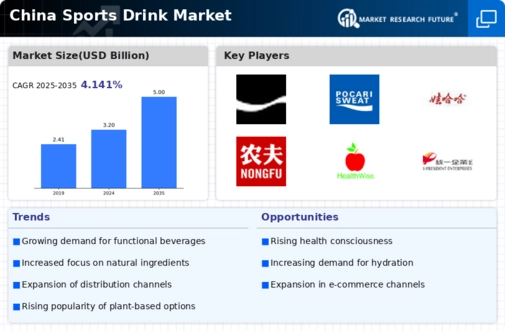The sports drink market exhibits a dynamic competitive landscape, characterized by a blend of established brands and emerging players. Key growth drivers include increasing health consciousness among consumers, a surge in fitness activities, and the rising popularity of sports events. Major companies such as Gatorade (US), Powerade (US), and Pocari Sweat (JP) are strategically positioned to leverage these trends. Gatorade (US) focuses on innovation, particularly in product formulation and marketing strategies, while Powerade (US) emphasizes regional expansion and partnerships with sports organizations. Pocari Sweat (JP) has carved a niche through its unique hydration solutions, appealing to both athletes and casual consumers. Collectively, these strategies shape a competitive environment that is both collaborative and competitive, as companies seek to differentiate themselves in a crowded marketplace.
Key business tactics employed by these companies include localizing manufacturing to reduce costs and optimize supply chains. The market structure appears moderately fragmented, with several key players holding substantial market shares. This fragmentation allows for a diverse range of products and marketing strategies, fostering competition that drives innovation and consumer choice. The influence of major players is significant, as they set trends that smaller brands often follow, thereby shaping the overall market dynamics.
In October 2025, Gatorade (US) launched a new line of electrolyte-infused beverages aimed at enhancing athletic performance. This strategic move underscores Gatorade's commitment to innovation and its focus on meeting the evolving needs of athletes. By introducing products that cater specifically to performance enhancement, Gatorade (US) reinforces its position as a leader in the market, potentially attracting a broader consumer base.
In September 2025, Powerade (US) announced a partnership with a leading fitness app to integrate hydration tracking features. This initiative not only enhances user engagement but also positions Powerade (US) as a tech-savvy brand that prioritizes consumer health. By leveraging digital platforms, Powerade (US) aims to create a more personalized experience for its customers, which could lead to increased brand loyalty and market share.
In August 2025, Pocari Sweat (JP) expanded its distribution network in China, focusing on tier-two and tier-three cities. This strategic expansion reflects a growing recognition of the potential in less saturated markets. By increasing accessibility, Pocari Sweat (JP) aims to capture a larger share of the consumer base, particularly among younger demographics who are increasingly health-conscious and active.
As of November 2025, current trends in the sports drink market are heavily influenced by digitalization, sustainability, and the integration of AI technologies. Companies are increasingly forming strategic alliances to enhance their market presence and operational efficiency. The competitive landscape is shifting from traditional price-based competition to a focus on innovation, technology, and supply chain reliability. This evolution suggests that future differentiation will hinge on the ability to adapt to consumer preferences and technological advancements, ultimately reshaping the market dynamics.




















Leave a Comment